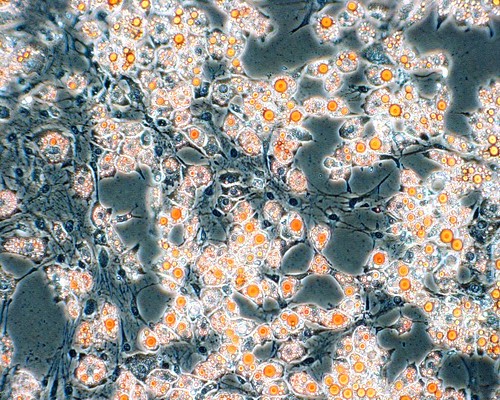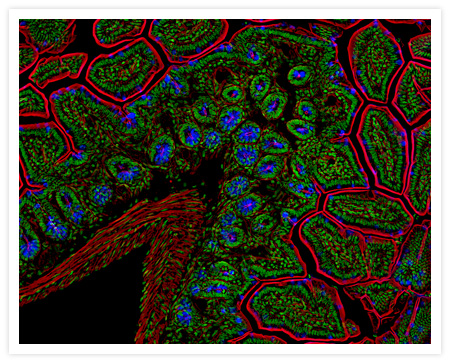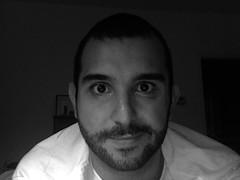Microcosms
Willing Warrior left a comment on my KrebsCast#6 post. He said, "I personally think that there is a HUGE link between science and the arts. It feels like you are pressing to bridge it... I'll be watching." Well I don't consider myself an artist and my job, most of the time, is not exactly what one would consider artistic. Test tubes, bags of blood, and pipets are not all together that interesting. The concepts behind the technicalities are the focus and draw of science. Maybe one could eek out a metaphor for art in the way that one decides to tell the story of their research, how they chose to explain the phenomena of nature. But lets not take this too seriously. Its science and at the heart of it it's about ego, fame, and glory by saying "I saw it first!" In any case, the result of an experiment can have unexpected aesthetically pleasing results. I thought of this image that I took last year.

This is an image of adipocytes (fat cells) that have been stained with a compound called Oil Red-O. Oil Red-O binds to lipids (oil) and stains them red. This photo was taken with a light microscope attached to a digital camera. This is from an experiment from when I worked with stem cells. These fat cells were made from other cells that I treated with some steroids, vitamins, and some extra carbs (I'm not kidding) and after a few days...Voila! Fat!
Now some of you might be thinking why are stem cell researchers making fat and where can I donate mine for money? Well in studying the development of fat it is possible to understand obesity and other disorders such as lipodystrophy (a lack of enough fat).
All that aside when I saw these cells after I had "made" them I thought it was actually quite beautiful. It was one of those days where I was glad to be working in science. Mostly because my experiment worked but partly because of the things I get to observe.
Its not art per se but its nice to look at and I made it.
There are even more sophisticated ways of imaging cells.

This photo, which is from Molecular Probes, is an example of using lasers to excite flourescent tags specific to different cells within a piece of tissue. Each color you see is excited by a different laser and the resulting images from each are layered one on top of the other to create a rather beautiful pattern. This particular image happens to be a cross-section of mouse intestine.
If you're really interested in learning more about floursecent imaging in biological research you can go here for a very nicely done tutorial.

This is an image of adipocytes (fat cells) that have been stained with a compound called Oil Red-O. Oil Red-O binds to lipids (oil) and stains them red. This photo was taken with a light microscope attached to a digital camera. This is from an experiment from when I worked with stem cells. These fat cells were made from other cells that I treated with some steroids, vitamins, and some extra carbs (I'm not kidding) and after a few days...Voila! Fat!
Now some of you might be thinking why are stem cell researchers making fat and where can I donate mine for money? Well in studying the development of fat it is possible to understand obesity and other disorders such as lipodystrophy (a lack of enough fat).
All that aside when I saw these cells after I had "made" them I thought it was actually quite beautiful. It was one of those days where I was glad to be working in science. Mostly because my experiment worked but partly because of the things I get to observe.
Its not art per se but its nice to look at and I made it.
There are even more sophisticated ways of imaging cells.

This photo, which is from Molecular Probes, is an example of using lasers to excite flourescent tags specific to different cells within a piece of tissue. Each color you see is excited by a different laser and the resulting images from each are layered one on top of the other to create a rather beautiful pattern. This particular image happens to be a cross-section of mouse intestine.
If you're really interested in learning more about floursecent imaging in biological research you can go here for a very nicely done tutorial.






9 Comments:
10:30 am on January 11th? This is way pre-posted...
Hello !
I'm loading your podcsat, I'm curious...
Have FUNNNNNNNNNN !
Bye.
Cetusss
You say it's not art per se, but it most certainly is. The instant you looked twice at it and loved it for just the way it looked...
Thye are great images.
Really nice photos Adam. Beauty is indeed, everywhere.
beauty is nature, nature is beauty, these photos demonstrate it perfectly.
I was always taught that art was where you found it - and that it is everywhere. You pics really show that. Several years ago, a tie company made ties where they had taken electron microscope pics of the celuar make up of certain alcohol and added color to them... very cool!
You made fat look pretty.
Wow...very pretty. And interesting to say the least.
OK, I know retroviruses are bad and they kill people, but when they're dead, tagged and under a scope there is a certain beauty to them.
Very cool, thanks Adam.
Post a Comment
<< Home